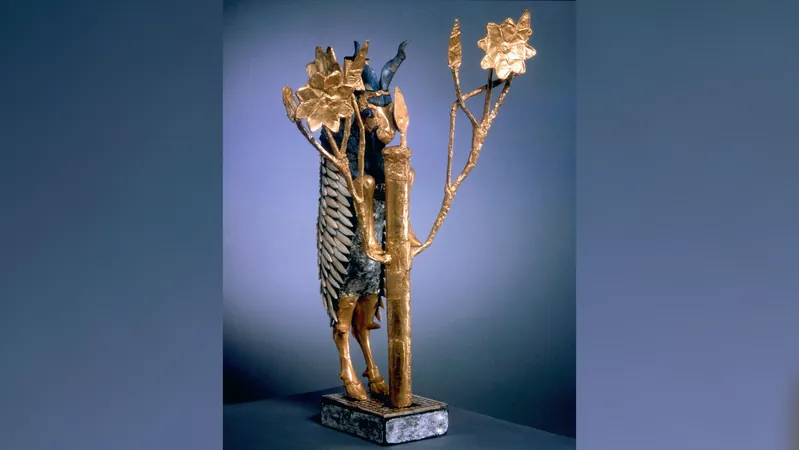
Unearthing the Secrets of 'Ram in the Thicket': A Stunning 4,500-Year-Old Treasure from Ur
2025-05-26
Author: Siti
Introducing a Gold Marvel from Ancient History
Behold the 'Ram in the Thicket,' a mesmerizing gold and lapis lazuli statuette that hails from the Royal Cemetery at Ur, located in modern-day Iraq. Crafted around 2550 B.C., this extraordinary artifact offers a glimpse into the rituals and beliefs of ancient Mesopotamia.
A Century-Old Discovery
Discovered a hundred years ago in a mass grave in southern Iraq, this stunning statuette may symbolize the daily rituals linked to fate and the genesis of the universe. Renowned archaeologist Leonard Woolley unearthed these twin statues, which he aptly named 'Ram in the Thicket,' during his excavation of the Great Death Pit in 1928.
This burial, believed to belong to a royal Sumerian individual, was not just a resting place; it involved the tragic sacrifice of 68 women and 5 men, revealing the often dark practices of the era.
An Artistic Masterpiece Reborn
Initially discovered in a state of destruction, the statuettes have since been meticulously restored. They stand at 16.7 inches (42.5 cm) and 18 inches (45.7 cm) tall respectively. The smaller statuette graces the Penn Museum in Philadelphia, while its larger counterpart resides at the prestigious British Museum in London.
Symbolism of the Statuettes
While experts speculate that these figures represent markhor goats, a species known for its magnificent spiral horns, Woolley referred to them as 'rams' due to their resemblance to the biblical tale of Abraham and Isaac. Each statue features wooden heads and limbs coated in gleaming gold leaf, augmented with copper ears and silver bellies. Lapis lazuli adds a deep azure hue, adorning their horns and fleeces.
Mystery of Their Purpose
The precise function of these intricate statuettes is still a topic of debate among scholars. Some suggest that they served as offering stands for small bowls that sadly did not survive the sands of time. Researchers from the Penn Museum, who probed deeper into their significance in 2020, interpret the thicket as a representation of the Mesopotamian cosmic tree—a bridge connecting the heavens and Earth.
The Cosmic Connection
In ancient Mesopotamian belief, daily sunrises held profound importance, symbolizing destiny and the birth of the universe. Rituals dedicated to Shamash, the sun god, often involved the sacrifice of goats and sheep between sunset and sunrise, linking this continuous cycle to life and rebirth. As guardians of this sacred time—where heaven, Earth, and the underworld converge—the 'Ram in the Thicket' statuettes were likely seen as essential components for a royal tomb.




 Brasil (PT)
Brasil (PT)
 Canada (EN)
Canada (EN)
 Chile (ES)
Chile (ES)
 Česko (CS)
Česko (CS)
 대한민국 (KO)
대한민국 (KO)
 España (ES)
España (ES)
 France (FR)
France (FR)
 Hong Kong (EN)
Hong Kong (EN)
 Italia (IT)
Italia (IT)
 日本 (JA)
日本 (JA)
 Magyarország (HU)
Magyarország (HU)
 Norge (NO)
Norge (NO)
 Polska (PL)
Polska (PL)
 Schweiz (DE)
Schweiz (DE)
 Singapore (EN)
Singapore (EN)
 Sverige (SV)
Sverige (SV)
 Suomi (FI)
Suomi (FI)
 Türkiye (TR)
Türkiye (TR)
 الإمارات العربية المتحدة (AR)
الإمارات العربية المتحدة (AR)